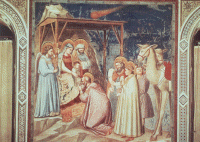Giotto di Bondone
 Biography
Biography
Giotto, son of Bondone, was born in Colle di Vespignano, near Florence, in 1267. According to tradition, Giotto's talent was discovered by painter Cimabue, who saw him painting a sheep on a stone. Cimabue took him to his workshop in Florence, where Giotto spent his apprenticeship from 1280 to 1290. Abandoning the very rigid and symmetrical, Byzantine style, he created a much more realistic one of his own. Giotto started a competely new style, "translating the art of painting from Greek to Latin."
Giotto's entire body of work constists of frescoes and altar pieces. Unfortunately, few survived the centuries. One of Giotto's best preserved masterpieces is the cycle illustrating the lives of the Virgin and Christ in the Scrovegni Chapel in Padua, Italy. Giotto, who was already famous for his work in Assisi and in Rome, worked in Padua together with his team from 1304 to about 1306. Their/His frescoes include an "Adoration of the Magi" (Adorazione dei Magi), which features a beautiful comet above the Nativity stable.
Figure 1. Giotto's fresco showing Comet Halley
Giotto's comet looked very realistic, obviously painted by someone who had seen a comet and could render it as it really was. In October 1301 comet Halley had made itself conspicuous in the skies of Europe. The eminent historian Giovanni Villani described the comet with "great rays of fumes behind." No doubt, Giotto had seen it and remembered it well enough to paint his visual experience as the star of Bethlehem for the "Adoration of the Magi." Shattering the schematic, artistic conventions for representing comets, Giotto gave us the first unambiguous portrait of a comet which must have been Halley, since no other comet was recorded between 1301 and the completion of the Scrovegni frescoes. According to non-documented tradition, Dante visited Giotto in Padua and went as far as to say, "Now Giotto has the acclaim." ESA paid great tribute to Giotto's work by naming its probe to comet Halley after him.

